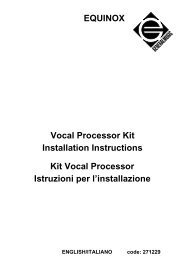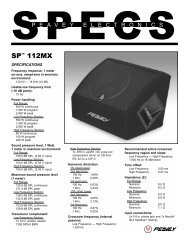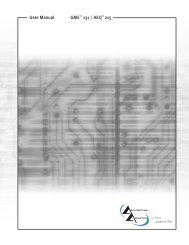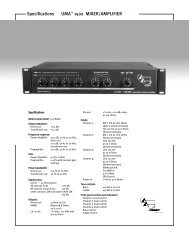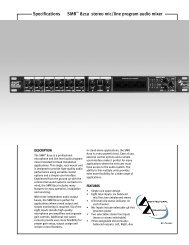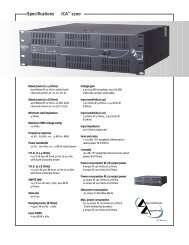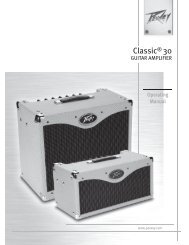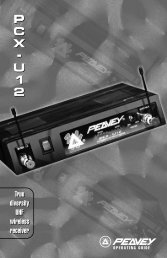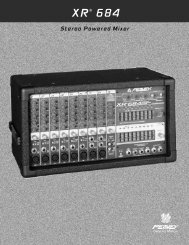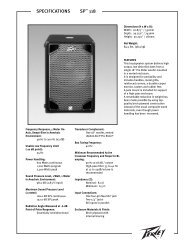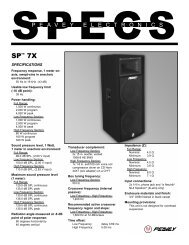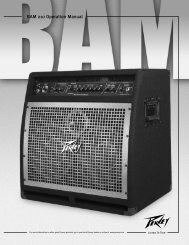GPS Series Amplifiers GPS Series Amplifiers - Peavey
GPS Series Amplifiers GPS Series Amplifiers - Peavey
GPS Series Amplifiers GPS Series Amplifiers - Peavey
Create successful ePaper yourself
Turn your PDF publications into a flip-book with our unique Google optimized e-Paper software.
LINE CORD<br />
For your safety, we have incorporated a removable 3-wire line (mains) cable with proper grounding<br />
facilities. It is not advisable to remove the ground contact under any circumstances. If it is necessary to<br />
use the equipment without proper grounding facilities, suitable grounding adapters should be used. Less noise<br />
and greatly reduced shock hazard exists when the unit is operated with the proper grounded receptacles.<br />
NOTE: Always turn off the amplifier before making audio connections. As an extra precaution, have the input<br />
attenuator turned down during power-up.<br />
COOLING REQUIREMENTS (<strong>GPS</strong> 900 and 1500)<br />
These <strong>GPS</strong> <strong>Series</strong> amplifiers use a forced-air cooling system to maintain a low, even operating temperature.<br />
Cooling air is drawn by synchronized, variable-speed fans mounted on the back panel, and exhausts through<br />
slots on the front panel. The fans will remain at low speed until internal operating temperature rises above<br />
45 0 C. Make sure that there is enough space around the back of the amplifier to allow air to enter. The normal<br />
operating temperature is 55 0 C. This is a very cool temperature when compared to most amplifier standards.<br />
What this means to you is a noticeable increase in product life. On the <strong>GPS</strong> 900 and 1500 models, the fans<br />
will turn on simultaneously when temperature activated.<br />
COOLING REQUIREMENTS (All models except <strong>GPS</strong> 900 and 1500)<br />
These <strong>GPS</strong> <strong>Series</strong> amplifiers use a forced-air cooling system to maintain a low, even operating temperature.<br />
Cooling air is drawn by continuously variable speed fans mounted on the back panel, and exhausts through<br />
slots on the front panel. The fan will remain inactive until internal operating temperature rises above 45 0 C.<br />
Make sure that there is enough space around the back of the amplifier to allow air to enter. The normal<br />
operating temperature is 55 0 C. This is a very cool temperature when compared to most amplifier standards.<br />
What this means to you is a noticeable increase in product life.<br />
NOTE: If the amplifier is rack-mounted, do not use doors or covers on the front or back while the unit is<br />
in operation. Whatever type of rack you are using, make sure that heated air can escape freely, and that<br />
there is no resistance to the intake of cool air through the back grill. Intake and exhaust air must flow without<br />
resistance.<br />
INPUT CONNECTIONS<br />
The input connector accepts balanced and unbalanced audio signals. For use with an unbalanced source, tie the<br />
inverting (-) input to ground by installing a jumper to the signal ground connection. If the inverting input is<br />
left floating, a 6 dB loss in gain will result.<br />
SIGNAL MODE CONFIGURATION<br />
<strong>GPS</strong> <strong>Series</strong> amplifiers are configured for two-channel (stereo) or bridged mode operation at the input<br />
connectors and via Mode Switch. To send the same signal to both channels, connect the input signal to<br />
Channel A via the input connector. Run a jumper from the Thru jack of Channel A to the input of Channel B.<br />
Both channels then share Channel A’s input signal, but will operate independently. Speakers are connected as<br />
in two-channel (stereo) mode.<br />
Bridged mode converts the amplifier into a single-channel unit with a power rating equal to the sum of both<br />
channels’ power ratings, and at a load rating of twice that of the single-channel rating. In bridged mode, the<br />
channels operate at opposite polarity of each other so that one channel “pushes” and the other “pulls” equally.<br />
Signal is connected to the Channel A Input connector. The speakers are connected only to the designated “+”<br />
output terminals. Never ground either side of the speaker cable when the amplifier is in bridged mode, as both<br />
sides are “hot”. For <strong>GPS</strong> <strong>Series</strong> amplifiers, the minimum nominal load impedance in bridged mode is 4 ohms;<br />
this is the equivalent of driving both channels at 2 ohms. Driving loads of less than 4 ohms may activate the<br />
thermal protect circuitry.<br />
10




